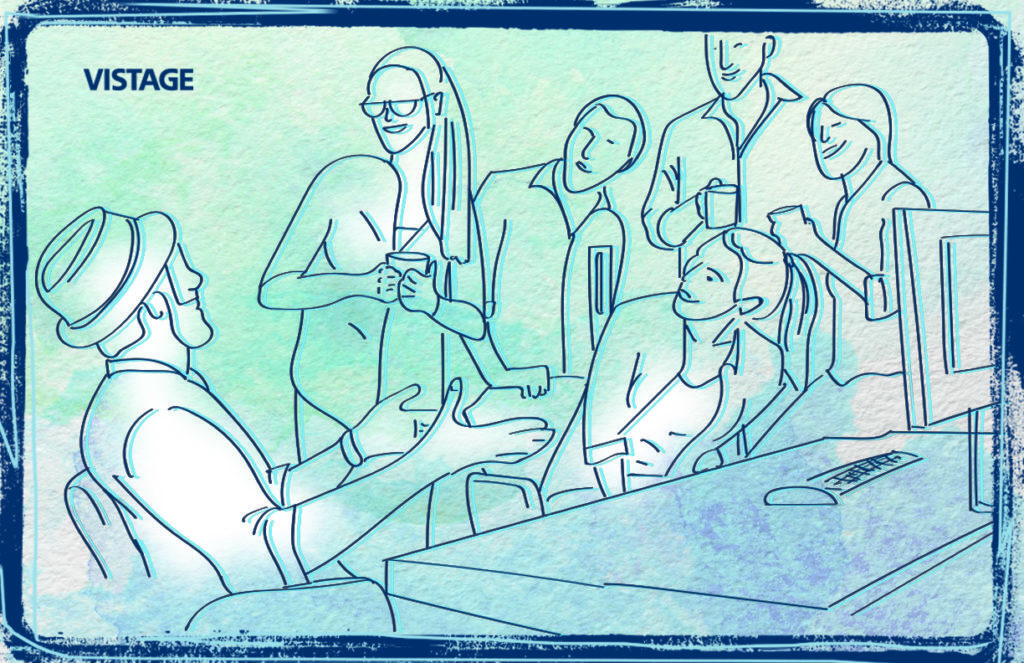The neuroscience of co-creation: 3 ways to foster self-expression in the workplace

 I have yet to meet an executive, who joins a company to be minimized, marginalized or intentionally held back from making a contribution.
I have yet to meet an executive, who joins a company to be minimized, marginalized or intentionally held back from making a contribution.
We join a company to make a difference, to make a contribution, to be praised and rewarded. We join a company to bring our voice to the table, and ‘lean into conversations’ so our voices join in the spirit of partnering with others to shape, create and co-create the future.
Neuroscience is teaching us that ‘self-expression’ might be one – if not the most important – way for people to connect, navigate and grow with each other.
1. Validate View and Voice
This experience suggests that something important happens inside of us when our view of the world is validated publicly – when our voice is heard and acknowledged, when we see we are not alone in our inner thoughts. This article is inspired by an experiment I ran over 25 years ago that created the impetus for the birth of Conversational Intelligence® – how we use conversations to connect with others to share a common view of the world.
When my children were in elementary school, I created a school project called Children’s World. I proposed that we gather the students’ stories and pictures, and compile them into a book and publish it. When I shared this idea with the principal and teachers, they got behind it and offered to help. When I shared this idea with some parents, I soon had 20 volunteers. When we shared this idea with 550 students, we had all of their contributions within weeks.
As we began to compile the books, we laid all of the contributions on the floor – everything from stories and pictures from the 5th graders, to poems and pictures from 1st graders – and looked for how we could best combine them.
At the end of our pattern-seeking process, all of the art and stories came together into chapters organized by themes that emerged as we sorted. We found children’s stories from 1st grade to map into illustrations from children at a higher grade. We found a local printer who printed enough for parents to buy for their children and others. The books sold out in the first two days, and we had to re-order them.
The teachers told us there was an upsurge of creativity during the years we published Children’s World. Other schools in our community heard about the project and began their own Children’s World project.
Later, we did a follow-up study, looking for possible connections that might show the impact of the projects on the children’s emotional, social and academic development. We found a positive impact from the few years we did the Children’s World projects – a direct correlation to the number of children who were accepted into top universities, measurably more than in the years before or after.
2. Self-Expression at Work
How do you drive self-expression in the workplace? How do you encourage speaking up? In what ways can people apply their talents to create the next generation products and services your company offers?
Conversational Intelligence (C-IQ) teaches us to see differently – to listen differently – and to process what we perceive differently. When we do that, we act in the moment in ways that create energy, activate energy, and help guide energy toward more productive and more powerful ends. C-IQ gives us tools for letting go of the past and transforming the future.
As you become transparent about your aspirations and intentions to co-create and also what threatens you – your fears and “stories” about what is going on – you feel a release inside. You gain the courage and a space to share your views without judgment. You could speak out and have a voice, and not be judged for how you are feeling. You have a chance to speak out and have your opinions valued.
You can reveal your inner thoughts and feelings to one another to work on Transparency + Relationship together. You can talk about what is bothering you and what you aspire to create. You can move from a state of protection to partnering with others by being open to sharing and discovering their fears and aspirations.
3. Co-Create Conversations to Bridge Realities
By stepping into one another’s shoes and listening without judgment, you trigger the prefrontal cortex (the executive brain) to access higher-level capacities, including how to handle gaps between reality and aspirations; how to access new thinking; and how to move into infinite thinking together and co-create new possibilities. Without this part of the brain activated, you tend to fall back into positional thinking and fight for your vested interests. You become more candid and caring and speak truth in trust, without triggering fear, creating the space for shared success.
Breakthroughs occur, as you stay open to the possibility that you might discover ideas you have never thought of before. As you create a bonding experience (oxytocin rush), you start to open up new conversations about “what ifs.” You imagine new things that you might do together, fostering higher risk taking and openness. Co-creation opens the “infinite space” our minds need to be free to connect with others in new ways. Positioning, politicking, interpretation, drama, and negative storytelling give way to a sense of shared success and bonding that shapes new relationships.
Achieving greatness depends on the quality of the culture, which depends on the quality of relationships, which depends on the quality of conversations. Everything happens through conversation {Click to tweet this}. By grafting C-IQ rituals into your interaction dynamics, you will discover new doors opening up in your mind and in your reality.
Try These Experiments:
- Think about how to craft an exercise like Children’s World in your organization, team, or school to allow validation of voice and view.
- Collect success stories in teams and publish them—watch how the team spirit changes.
- Start a meeting by asking people to share a personal story and a business story that just happened that they are excited about—see how the meeting shifts.
- In team meetings, share, “What I respect about you and what I need from you.” This exercise helps you understand others, recognize strengths in others and prime one another for partnering and co-creation as you create openness, bonding, connectivity, and empathy for one another.
- Publish success stories on your intranet. Ask people to include tips, and practices that underlay the success—watch how the C-IQ grows in your organization.
Do you have an example of how co-creation and conversations have affected your business? Share below.
Judith E. Glaser is CEO of Benchmark Communications, Inc., Chairman of The Creating WE Institute, an Organizational Anthropologist, consultant to Fortune 500 Companies, and author of four best selling business books, including Conversational Intelligence: How Great Leaders Build Trust and Get Extraordinary Results (Bibliomotion). Call 212-307-4386 or visit www.conversationalingelligence.com; www.creatingwe.com; email jeglaser@creatingwe.com. https://www.benchmarkcommunicationsinc.com/
Category : Talent Management


